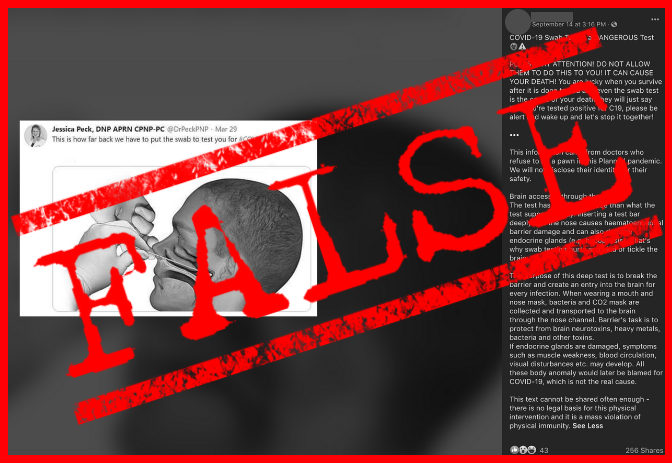Multiple Facebook (FB) posts published by the same netizen on Sept. 14 and which continued to circulate this month falsely claim that the COVID-19 nasal swab test is “dangerous” and could cause death. The swab inserted through the nose allegedly “damages” the endocrine glands and “breaks” the blood-brain barrier, allowing infections to reach the brain.
This is not true. This claim has been debunked by multiple health experts.
A group of public health researchers and scientists convened by international nonprofit organization Meedan said it is “virtually impossible” for a nasal swab to “access or have any impact” on the blood-brain barrier.
“Rupturing the blood-brain barrier would require breaking through multiple layers of tissue, drilling through bone, and going through blood vessels, which is not possible with a nasal swab,” they said in Meedan’s COVID-19 Expert Database website.

The blood-brain barrier is a layer of cells separating blood vessels from other parts of the brain. It shields the organ from “circulating toxins or pathogens” in the blood—including viruses—that could infect the brain.
The netizen’s claim gained further interest this month after a woman in her 40’s was reported to have leaked brain fluid from her nose after a swab test in the United States.
In an interview with the Associated Press, Morgan Katz, an assistant professor of medicine at Johns Hopkins University, said she thinks it is “not possible” for the swab to get anywhere near the blood-brain barrier.
She added that a person is more likely to compromise the blood-brain barrier “by being infected with a harmful virus” than by getting tested for it.
Nasopharyngeal swab testing is the method used in collecting samples for the reverse transcription-polymerase chain reaction (RT-PCR) testing, used to detect the presence of SARS-CoV-2, the COVID-19-causing virus, in individuals. (See The science behind COVID-19 testing)
It involves inserting a six-inch long swab into the nose until it reaches the upper area of the throat called the nasopharynx, where the swab is rotated to absorb secretions that potentially contain the virus.
Meedan’s experts said nasal swab testing is a “completely standard and safe procedure” that has no short- nor long-term harms, although people may experience minor discomfort having an object being inserted into the nose.
They also said the technique “cannot rupture the blood-brain barrier or the endocrine glands, nor can it infect the brain.”
The spurious FB posts were reshared this month three days after a woman in the US made headlines, when a COVID-19 swab test punctured her brain lining and caused fluid to leak from her nose. Doctors said it happened due to a sequence of improbable events: the woman having an undiagnosed rare condition and the swab test may have been improperly carried out.
The circulating posts carried a screen grab of a March 29 tweet by Jessica Peck, a professor from the Baylor University Louise Herrington School of Nursing, featuring a photo illustrating how a nasal swab test is done.
The false posts collectively accumulated over 300 reactions and nearly a thousand shares. Two were each published in public FB groups FLAT EARTH SCIENCE AND BIBLE DISCUSSION, created in May 2017, and PLANDEMICoVid¹⁹ WORLDWIDE, created just last Aug. 28.
(Editor’s Note: VERA Files has partnered with Facebook to fight the spread of disinformation. Find out more about this partnership and our methodology.)





